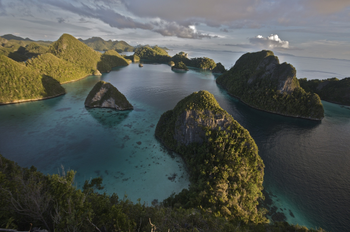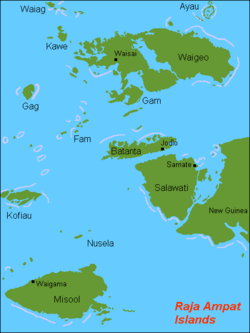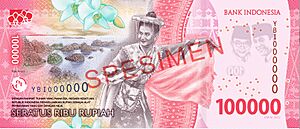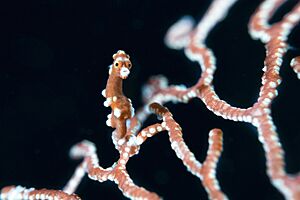Raja Ampat Islands facts for kids
|
Native name:
|
|
|---|---|

Panoramic view
|
|

Map of the islands
|
|
| Geography | |
| Coordinates | 0°14′00″S 130°30′28″E / 0.2333115°S 130.5078908°E |
| Archipelago | Melanesia |
| Total islands | 612 |
| Major islands | Misool Salawati Batanta Waigeo |
| Area | 8,034.44 km2 (3,102.11 sq mi) |
| Administration | |
| Province | Southwest Papua |
| Regency | Raja Ampat Regency |
| Demographics | |
| Population | 66,839 (mid 2022 estimate) |
| Pop. density | 8.32 /km2 (21.55 /sq mi) |
Raja Ampat, also known as the Four Kings, is a group of islands in Indonesia. It is located off the northwest tip of New Guinea island, in the Southwest Papua province. This amazing place has over 1,500 small islands, sandbars, and shallow areas. These are spread around four main islands: Misool, Salawati, Batanta, and Waigeo. There is also a smaller island called Kofiau.
The Raja Ampat islands are right on the equator. They are part of a special ocean area called the Coral Triangle. This area has the richest variety of sea life on Earth! The Coral Triangle covers parts of Southeast Asian seas. It includes areas near the Philippines, Borneo, and New Guinea. Thousands of different sea creatures live here. You can find tiny cleaner shrimp and pygmy seahorses. There are also huge whales and whale sharks.
Most of these islands are part of the Raja Ampat Regency. This is a local government area. It was created in 2004. The regency covers about 70,000 square kilometers (27,000 square miles) of land and sea. The land area is about 8,034 square kilometers (3,102 square miles). In mid-2022, about 66,839 people lived here.
Contents
What is the History of Raja Ampat?

People first visited the Raja Ampat Islands over 50,000 years ago. This is known from old tools and remains found by archaeologists. Back then, Misool and Salawati islands were connected to New Guinea. Waigeo and Batanta islands formed one large island called Waitanta. Early people here processed tree sap and hunted animals. About 3,500 to 3,000 years ago, groups who made pottery arrived. They might have brought new languages to the area.
The name Raja Ampat means "Four Kings." It comes from a local story. The story says a woman found seven eggs. In one version, this woman was Boki Tabai. She was the daughter of Al-Mansur of Tidore. Three of the eggs hatched into kings who ruled the Raja Ampat Islands. Another egg hatched and settled in Waigama. The fifth egg became a woman who went to Biak Island. The sixth egg became a spirit. The last egg did not hatch and turned to stone. It is worshipped as a king in Kali Raja.
Historically, the "four" kingdoms were Waigeo, Salawati, Sailolof, and Misool. Waigama was also sometimes included.
The first Europeans to see Raja Ampat were Portuguese explorers. This happened in 1526. The explorer Jorge de Menezes and his crew landed there. They were on their way to Halmahera.
Islam came to the Raja Ampat Islands in the 1400s. This was through trade and political links with the Sultanate of Bacan. In the 1500s and 1600s, the Sultanate of Tidore (from the Maluku Islands) had strong ties with Raja Ampat. During this time, Islam became well-established. Local leaders started to become Muslim. Because of these ties, Raja Ampat was considered part of the Sultanate of Tidore. Later, the Dutch took control of the Maluku Islands. They then claimed Raja Ampat as well.
The English explorer William Dampier gave his name to Dampier Strait. This strait separates Batanta Island from Waigeo Island. Another strait separates Batanta from Salawati. In 1759, Captain William Wilson sailed through these waters. He named a strait the 'Pitt Strait' after his ship. This was likely the channel between Batanta and Salawati.
What is the Climate Like in Raja Ampat?
The islands have a tropical climate. This means it is warm all year round. Temperatures usually range from 20 to 33 degrees Celsius (68 to 91 degrees Fahrenheit).
The ocean water temperature is also warm. In North Raja Ampat, it is about 28 to 30 degrees Celsius (82 to 86 degrees Fahrenheit). In the South, near Misool, it is a bit cooler. It ranges from 26 to 28 degrees Celsius (79 to 82 degrees Fahrenheit).
What Animals and Plants Live in Raja Ampat?
Land Animals and Plants
The islands are covered in rainforests. These forests are home to many kinds of birds, mammals, reptiles, and insects. Two special kinds of bird-of-paradise live here. They are the red bird-of-paradise and Wilson's bird-of-paradise. These birds are found only on the islands of Waigeo, Gam, and Batanta.
A newly found palm tree also grows only in Raja Ampat. It is called Wallaceodoxa raja-ampat.
Marine Life and Coral Reefs
Raja Ampat is known as the world's center for tropical sea life. It is called "The Crown Jewel" of the Bird's Head Seascape. This area has over 600 types of hard coral. This is about 75% of all known coral species in the world! It also has more than 1,700 kinds of reef fish. This includes fish living in shallow and deep reefs.
Compared to other places, Raja Ampat has the most diverse sea life on Earth. Rare and endangered sea mammals live here. These include dugongs, many types of whales, dolphins, and even orcas. The huge whale sharks, the biggest fish on Earth, also live in these waters.
In the northeast of Waigeo Island, local people help protect sea turtles. They protect nests or move eggs to safer places. This helps leatherback, olive ridley, and hawksbill turtles. Local government and groups that help the environment support their work.
The Raja Ampat Marine Recreation Park was created in 2009. It protects four main sea areas. These include waters around northern Salawati, Batanta, and southwestern Waigeo. It also covers Mayalibit Bay in central Waigeo. Other protected areas are southeast of Misool and around the Sembilan Islands.
The rich sea life in Raja Ampat makes it a great place for tourism. Many divers and researchers come to explore the underwater world.
Experts say that Raja Ampat has the highest variety of sea life ever recorded. It has much more diversity than any other area in the Coral Triangle. This makes Raja Ampat possibly the richest coral reef ecosystem in the world.
The huge coral groups here can also handle threats better. Things like coral bleaching and coral diseases are less harmful here. This is because of the warm sea temperatures. The Raja Ampat islands are also far away and mostly untouched by people.
However, a type of starfish called the crown-of-thorns starfish eats corals. These starfish can grow very large. They are covered in sharp, stinging spines. They have grown in number because of more human waste in the water. This waste causes more tiny plants to grow, which the starfish eat. In 2019, local divers started to reduce the starfish numbers. They inject the starfish with a vinegar solution. Then, local fish can eat the dead starfish.
Raja Ampat's high sea diversity is due to its location. It sits between the Indian and Pacific Oceans. This allows coral and fish babies to spread easily between the two oceans. Raja Ampat's corals are strong and help spread new life. This makes it a very important place to protect the ocean.
The variety of sea life is amazing. There are 1,508 fish species and 537 coral species. This is about 96% of all known hard corals in Indonesia. It is also 75% of all species that exist in the world! There are also 699 types of mollusks. Raja Ampat has over 100 types of reef fish found nowhere else.
The Raja Ampat Islands have at least three ponds with harmless jellyfish. These are all in the Misool area.
In March 2017, a large cruise ship called Caledonian Sky ran aground on a reef. It was stuck during low tide. Experts estimated that 1,600 square meters (17,222 square feet) of the reef were destroyed. This caused a lot of damage. It will take many decades for the reef to recover.
A project started in 2022 to breed and release zebra sharks. The goal is to release 500 sharks by 2032. The number of wild zebra sharks became very low in the 1990s because of fishing.
Who Lives in Raja Ampat?
Most people in Raja Ampat work as fishers. This is because the area is mostly sea. They live in small groups of tribes spread across the islands. They welcome visitors, and their traditional culture is still very strong. The people of Raja Ampat are similar to the nearby Moluccan and Papuan people. They speak Papuan and Austronesian languages.
Religion in Raja Ampat (2010) Protestantism (67.34%) Roman Catholicism (0.76%) Islam (31.83%) Hinduism (0.06%) Buddhism (0.01%)
How is Raja Ampat Governed?
Most of the islands are part of the Raja Ampat Regency. This is a local government area in Southwest Papua. It was created in 2004. Before that, it was part of the Sorong Regency. The southern part of Salawati Island is not part of Raja Ampat Regency. It belongs to the Sorong Regency.
The Raja Ampat Regency is divided into smaller areas called districts (kecamatan).
Images for kids







